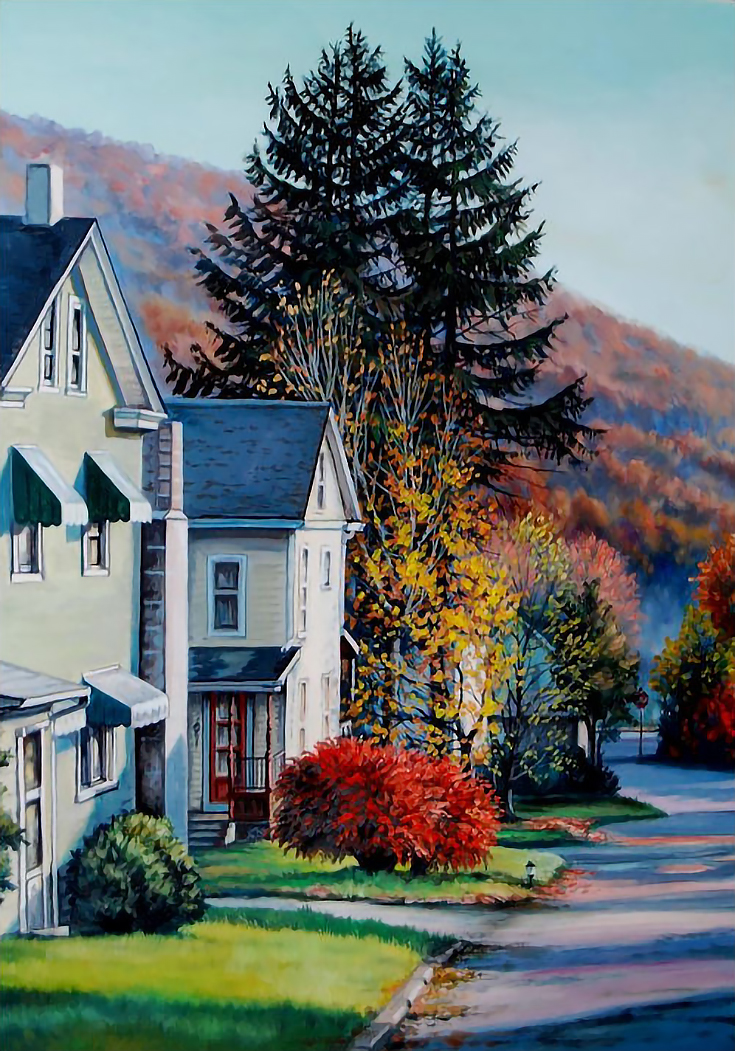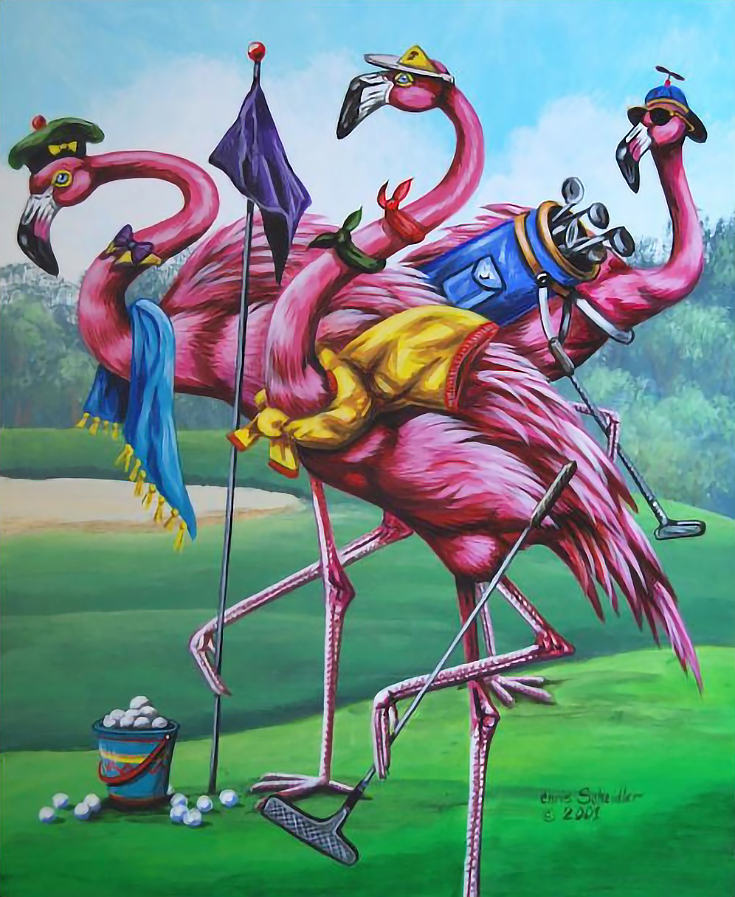 As a child, Chris Scheidler Pagano loved to draw get-well cards for family and neighbors, and was often encouraged by her grandparents to spend hours drawing. By 11 she was taking painting lesson, and hasn’t stopped painting since.
As a child, Chris Scheidler Pagano loved to draw get-well cards for family and neighbors, and was often encouraged by her grandparents to spend hours drawing. By 11 she was taking painting lesson, and hasn’t stopped painting since.
Chris has earned her living as an artist for over 34 years, mainly by exhibiting in art shows and craft festivals throughout the Mid-Atlantic region of the US. She has won several art competitions and best-of-show awards, held solo gallery shows, and has also had her work published.
Alyice: You’ve been creating art for all of your adult life, and most of your childhood, what is it about art that keeps you going? How does creating art make you feel?
Chris: Creating art makes me feel wonderfully alive, happy, engaged, important, and challenged.
Every day is a thrill because I get up knowing I can draw or paint or do something related to my art business. That is my work, my purpose in life.
Being an artist is a blessing. I have been blessed to be able to earn a living doing something I love. Sharing these gifts with the world, to be a blessing to others, is a great task in life, don’t you think?
Alyice: You work with both acrylics and oil paints. Can you tell us why you switch between those two mediums?
Chris: I started my professional career painting in oil. I love oils the best because of their opaqueness, their rich colors (acrylics seem plastic in comparison) and the fact that they do not dry so fast; allowing me to blend and smooth. They also allow me to better blend colors in a large area—like the sky, water and large animal bodies.
I switched to acrylics for a lot of my work when the show schedule demanded constant new (and completely dry!) work. I could not paint exclusively in oils and fill my art booth with paintings because the new paintings simply did not dry fast enough.
In some of my paintings, I incorporate both oils and acrylics in the same piece. I use oils to paint the backgrounds and large areas and acrylics to paint the figures (i.e. the wildlife) and detailed portions of the foreground.
Alyice: What is the most challenging part about working with oils?
Chris: The most challenging part of painting with oils is having the patience to work with the buttery consistency when doing detailed work and the drying time. It can be frustrating when I want to continue working on a piece but can’t because it is too wet to work on.
Alyice: What is the best part about working with acrylics?
Chris: The best part about working with acrylics is the very opposite of the challenging part of working with oils. Acrylics dry fast, so I can continue working on a piece until I come to a natural stopping point.
Alyice: What do you wish you knew about painting before you got started?
Chris: I wish I had known what a toll certain elements of painting for a living would take on my body—my vision is shot from painting extremely small, detailed work; my fingers and hand gets numb from holding the brush; and my back is shot from lifting heavy objects like my booth and display to loading and unloading to carrying, setting up and tearing down the displays, 25 to 30 times a year for 30+ years.
You would not think being an artist is such a strenuous job, but anyone who does art shows for a living will tell you otherwise!
Alyice: You often refurbish old furniture by painting your unique wildlife scenes directly onto the furniture, how did you get started in this?
Chris: I got started in this venue by first creating pieces for my own home. They created a lot of interest. . . prompting my family, friends, and customers to encourage me to sell these “functional art pieces” at art shows.
Alyice: How do you protect your art when it’s on such useable pieces?
Chris: I put several coats of high grade lacquer on the finished piece to seal and protect it.
The lacquer will protect and preserve the piece from normal wear and tear. However, care should be given to each piece as these pieces will not withstand any sort of abuse, like a dog chewing it or a child slamming or throwing it against a wall. Also, cigarette ashes will mar the surface and water will damage the surface if left unattended for a long period of time. But with common sense, these pieces will last a long, long time.
Alyice: What is your creative process like?
Chris: All my paintings start with an idea. The most important aspect of a painting is that the artwork is based on an original idea. An original idea is one conceived by the artist through something they have seen, experienced, felt, or imagined.
The ideas for my realistic paintings come from something I have seen and observed like walking in the woods and noting the way the sunlight plays through the trees, or chancing upon a fox tracking across an open snowy field, or a great blue heron flying over a marsh that I spotted while driving, or watching a cardinal in my backyard while sipping my morning coffee, or observing the play of sunlight and shadows on homes and buildings as I walk through town to get the mail.
The ideas for my whimsical portrayals, however, come from an inner “what if. . .”
Once I have an idea down, I do small studies before starting a large project.
This starts with a simple pencil sketch and progresses into a small but semi-detailed color drawing and then ends when I translate the idea onto a large surface.
This works well, for me, because I can solve many of the initial painting problems on paper before I start the actual work. It also is very important when doing custom work where you need the okay from the buyer before starting on the painting.
Alyice: How has your style changed over the years?
Chris: My style started out realistic, got a bit impressionistic during my college years and afterward I had a period where I worked exclusively in palette knife.
When I started doing wildlife shows for a living, my style turned more realistic. Over the years it evolved to include impressionistic backgrounds and whimsical illustrations—all prompted first by what I enjoyed doing and secondly, by how well it paid the bills.
I have always tried to maintain a balance between what I enjoy doing and what sold.
Today, I paint in three different styles: realistic wildlife; moody, impressionistic landscapes; and whimsical, illustrative portrayals of animals.
My style of painting is realistic, impressionistic and/or illustrative in nature, depending on the subject matter. All my paintings, regardless of style, are composed of long, graceful lines and bold, rich colors.
The subject matter has been animals for almost all of my art career, with some landscapes and seascapes thrown in here and there.
Alyice: How have you grown as an artist?
Chris: I’ve grown as an artist by constantly trying to improve myself, keeping tabs on the current trends in art, and by learning new things. And I strive to make each painting I do as good as I possibly can.
Alyice: What do you believe is a key element for creating visually appealing art?
Chris: It should convey the artist’s feelings—their love of the subject matter, their passion in creating it. Art is emotion and when the artist can communicate their passion so that the viewer is so moved, then that piece is a good painting.
Alyice: How do you come up with a profitable pricing structure for your pieces?
Chris: With great difficulty.
It has been very hard in this bleak economy to come up with a workable solution to pricing my paintings. I need to make a living so I price the paintings accordingly; yet I cannot afford to carry the same paintings around show after show. . . I need to sell them.
I need to refresh my booth with new work so it does not look “stale,” therefore I price them to sell.
Coming up with a compromise—one where I CAN actually make a decent living, and one where the paintings are priced so as to generate a moderately quick turnover is very tricky. The value of art is sadly determined by what people are willing to pay for it. Unfortunately, in this era of Wal-Mart-driven, discount pricing, cheap imported goods, and bargain basement online auctions, that value is greatly diminished.
Learn more about Chris Scheidler Pagano and her artwork at her website, WalnutStreetStudio.com, or her Etsy page.
This post may contain affiliate links.



